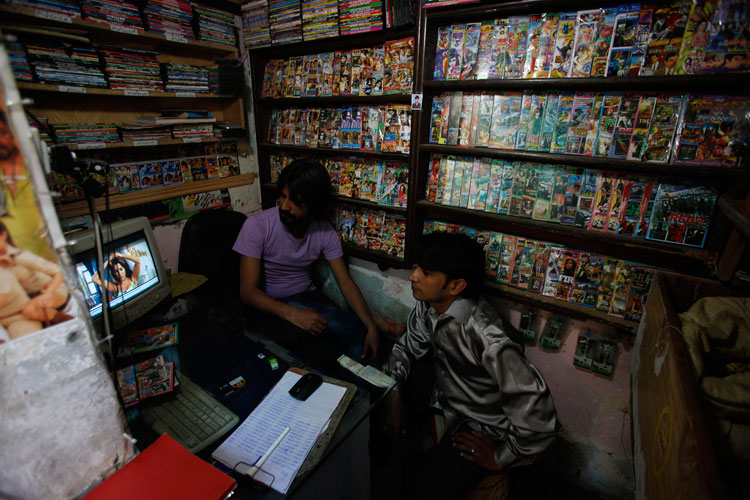At Tokyo Film Fest, Spotlight on Video Piracy Reveals Japan Is As Affected As India
During the first six months this year, about 15.2 million unique users in Japan accessed sites or applications facilitating online piracy every month. About 24 per cent of all the Japanese who used the internet downloaded pirated content.

This picture is for representational purpose only. Image courtesy: Reuters

Once, we were happy that pirates stayed away from shores. They were to be found at sea, mostly on the high seas, and romanticised as Long John Silvers in classics such as Robert Louis Stevenson's unforgettable 1883 Treasure Island. Ah! Who can forget that man leaning on his crutch with a parrot perched on his shoulder and singing “Yo-Ho Ho, a bottle of rum”.
But today, pirates have set foot on land and they no longer plunder treasure chests but run a multi-million industry which the world calls with dreaded distress video piracy.
India is undoubtedly one of the most notorious hubs -- with Puducherry termed as piracy capital -- where movies are converted into handy disks and sold in their thousands. Often such illegal copying takes place in villages and small towns after the last show is over, and camcorders are used to capture the fleeting images as projectors are clandestinely run.
Nobody, really nobody can tell me the actual amount that is lost through this illegal venture. There are hundreds of guesses. One avers that piracy in Indian pictures alone is now a whopping USD 250-million market. It is an industry employing thousands of people.
A Northbridge Capital Asia report contends that the Indian cinema industry, which produces around 1,300 titles in many, many languages every year, loses 14 percent of its revenue to video piracy. This can be an underestimated figure, for I am sure that the widespread practice of unlawful downloads from the internet has not been taken into account.
But piracy is not confined to India. It is growing menace in Japan as well, and this was the spotlight at the ongoing 30th edition of the Tokyo International Film Festival. On Friday (October 27), the Motion Picture Association of America presented its observations at a seminar.
"The challenge of online piracy, which is rampant everywhere, including Japan, is a serious problem for all of us," the Association Chairman, Chris Dodd, said in his opening remarks at the seminar.
The Director of the Festival who has just stepped in this year, Takeo Hisamatsu, agreeing with Dodd said that the piracy figures in Japan were “quite shocking”. Online piracy was a big problem in the country, though some people still felt that it was not alarming, he added.
During the first six months this year, about 15.2 million unique users in Japan accessed sites or applications facilitating online piracy every month. About 24 per cent of all the Japanese who used the internet downloaded pirated content.
Strange as it may seem, Japanese who are known to be among the most honest in the world are pirating with no qualms whatsoever. Marc Fuoti, President of Big Picture International, lamented that “piracy in Japan was on the rise”. And the rise was being seen as dramatic. The most pirated content were Manga and animation.
Despite the Japanese Government's move to aggressively curb piracy – like blocking the offending sites and seizing the domains guilty of promoting the evil – the rapid advances in the digital world have made it hard for the authorities to crack down on the pirates -- and easier for people to access material illegally.
India has been planning a host of moves. To check piracy, big Indian production houses like Yash Raj Films, UTV, Eros International, Shemaroo and Moser Baer joined hands some years ago to try and invest a ‘significant amount’ to counter the problem. However, they could not raise enough money for this.
Tamil producers have time and again planned measures to check piracy. Once, they wanted to stop all new releases for three months, and this, they felt, would dry up the pirates’ market. But with about three new openings every Friday, imagine the kind of pile up at the end of the moratorium in a State where there are not enough screens. Not at all.
Obviously, easier options have to be thought of. The window period between a theatrical and a video release must not be more than a few weeks. Big producers can factor in video rights in their agreements with distributors or make disks of their own movies at prices that will stop consumers from peeping into a pirate’s den. When Tamil superstar Kamal Haasan wanted to release his Viswaroopam on the Direct-to-Home platform and in the cinemas simultaneously, huge protests prevented him from doing so.
And today, I can walk into a seedy looking shop in Chennai and pick up the latest film – the DVD costing just Rs 40 compared to the Rs 207-odd for a cinema ticket in a multiplex. And in a country where most people cannot afford the luxury of entertainment, pirates offer a far cheaper option. The carrot they dangle is too tempting to resist.
Incredible, Japan by far richer than India and undoubtedly much more honest, seems to be as helpless in fighting the Long John Silvers on land!
 Live TV
Live TV
Recommended For You
 FIFA U-17 World Cup Final: Spanish Colts Hope to Emulate La Roja's 2010 Triumph
FIFA U-17 World Cup Final: Spanish Colts Hope to Emulate La Roja's 2010 Triumph Bollywood Has a Lot to Learn From Southern Cinema, Says Akshay Kumar
Bollywood Has a Lot to Learn From Southern Cinema, Says Akshay Kumar Madame Tussauds Delhi Unveils Justin Bieber’s Wax Figure At The Grub Food Fest
Madame Tussauds Delhi Unveils Justin Bieber’s Wax Figure At The Grub Food Fest WhatsApp 'Delete For Everyone' Feature: Now Unsend Wrongly Sent Messages
WhatsApp 'Delete For Everyone' Feature: Now Unsend Wrongly Sent Messages Do Women Really Need To Compete With Men?
Do Women Really Need To Compete With Men?


 4-min read
4-min read

